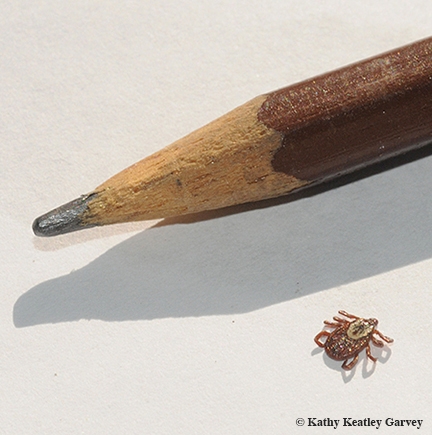
How much do you know about nematodes?
What would you like to know?
You'll be able to learn more about both, plus fleas, mites, lice, bed bugs, botflies and other critters, when the Bohart Museum of Entomology of UC Davis hosts an open house on “Parasite Palooza: Botflies, Fleas and Mites, Oh, My” from 1 to 4 p.m., Sunday, Jan. 22 in Room 1124 of the Academic Surge Building, Crocker Lane.
It's free and open to the public. You can meet scientists one-on-one and ask questions.
Senior public health biologist Mike Niemala of the California Department of Public Health will participate in the three-hour open house, discussing ticks and other health issues, and handing out fliers and brochures. He received his master of science degree from UC Davis.

What are nematodes? That's a question often asked of nematologists.
"Nematodes are a large group (phylum) of roundworms," Camp said. "Most nematodes are not parasites, but people may be familiar with some of the parasitic species. Some well-known nematode parasites of humans are pinworm, Ascaris, hookworm, and guinea worm. Dogs and cats can also become infected with nematodes including heartworm, hookworm, or Toxocara."
Camp, who grew up in rural northern Indiana, received her bachelor's degree in biology in 2005 from the University of Chicago and her master's degree in biology in 2007 from Wake Forest University, Winston-Salem, N.C. As a UC Davis graduate student, she focused on the evolutionary relationships and genetic diversity of Baylisascaris procyonis, a nematode parasite of raccoons. Her career plans? Researcher in infectious diseases or genetics/genomics or a science communicator.
"I first became interested in parasites during my undergrad degree at the University of Chicago," Camp said. "My specific interest in nematode parasites developed when I read some of Dr. Nadler's work on the evolutionary relationships of nematodes for an invertebrate biology class. Nematodes are an amazing phylum of organisms- they exist in almost every known environment on the planet, and different species eat everything from bacteria and fungi to plant and animal tissue. I find parasites particularly fascinating, because they are dependent on another organism (or organisms) for part or all of their life cycle."
The Bohart Museum event is free and open to the public. For the family craft activity, attendees will attach stickers of parasites on origami paper hats.
The Bohart Museum, directed by Lynn Kimsey, UC Davis professor of entomology, is a world-renowned insect museum that houses a global collection of nearly eight million specimens. It also maintains a live “petting zoo,” featuring walking sticks, Madagascar hissing cockroaches and tarantulas. A gift shop, open year around, includes T-shirts, sweatshirts, books, jewelry, posters, insect-collecting equipment and insect-themed candy.
The Bohart Museum's regular hours are from 9 a.m. to noon and 1 to 5 p.m. Mondays through Thursdays. The museum is closed to the public on Fridays, Saturdays and Sundays and on major holidays. Admission is free.
More information on the Bohart Museum is available by contacting (530) 752-0493 or bmuseum@ucdavis.edu.
Attached Images:
